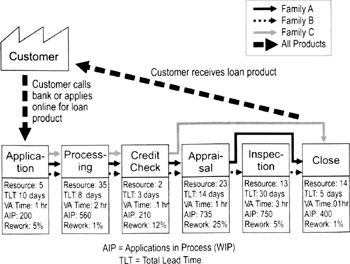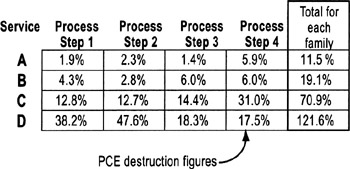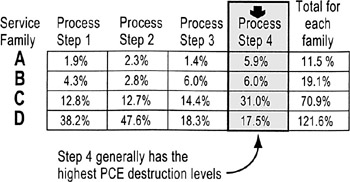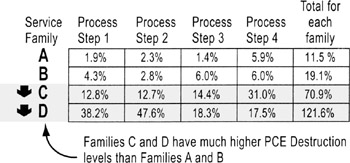Complexity Value Stream Mapping and Complexity Analysis
Overview
Purpose of these tools
Lean and Six Sigma tools are most often used to investigate problems with only one product or service. For example, the value stream map of page 45 followed only one high-volume product family down the process flow. But often the biggest contributor to non-value-add time and costs is the variety of products and services (and especially the impact of low-volume offerings).
The purpose of these tools is to help you diagnose and quantify complexity opportunities in your business unit or value stream. (For more information on complexity analysis, and for the strategic corporate-wide approach, refer to Conquering Complexity in Your Business, McGraw-Hill, 2004.)
Overview of Complexity tools
- Product/Service Family grid, p. 242—sorts your products or services into families based on which process steps they use and their costs. Use as prework for a complexity value stream map (to allow you to represent full diversity without mapping every single product or service through every process step).
- Complexity value stream map, p. 243—visually depicts the combined flow of multiple products or services through a process, which can highlight where complexity has its biggest impact.
- Complexity Equation for assessing the impact of complexity on Process Cycle Efficiency (PCE), p. 245—use to diagnose what process factors are contributing to low PCE.
- Complexity Matrix (including calculations of PCE destruction), p. 246 to 247—a table that allows you to compare the amount of process efficiency "eaten up" by products or services at each major process step. The goal is to answer the question: is what we're experiencing a process problem or a product/service problem?
- Substructure analysis, p. 248—illustrates opportunities to reduce complexity by exploiting common parts, procedures, etc., between products or services. Done as a check to prevent eliminating products or services that can be made less complex with little effort.
- "What if" analyses, p. 250—allows you to quantify the impact of the options you propose taking to reduce complexity.
Product service family grid
Purpose
- To help you determine where to focus limited resources on data collection and observation so you can create a complete complexity value stream map with the least time and effort
|
PROCESS STEPS |
|||||||||
|---|---|---|---|---|---|---|---|---|---|
|
Extended Volume (thousands) |
Margin |
Service |
Application |
Processing |
Credit Check |
Appraisal |
Inspection |
Close |
Family Class |
|
$1,040 |
2.0% |
Refinance ARM |
X |
X |
X |
X |
X |
A |
|
|
$5,200 |
2.5% |
Refinance Fixed |
X |
X |
X |
X |
X |
A |
|
|
$1,560 |
1.8% |
New Home ARM |
X |
X |
X |
X |
X |
X |
B |
|
$2,600 |
2.2% |
New Home Fixed |
X |
X |
X |
X |
X |
X |
B |
|
$520 |
1.5% |
Home Equity |
X |
X |
X |
X |
X |
C |
|
|
$780 |
1.4% |
Line Of Credit |
X |
X |
X |
X |
D |
||
When to use a product service family grid
- Prior to creating a complexity value stream map to identify representative products or services to include in the map
How to create a product service family grid
- List the subprocesses in a business unit, or within your project value stream, across the top of a matrix
- List each product or service down the side
- Mark which products/services use which processes
- Sort your products or services into families based on the similarity of process flow
- You can also include other factors such as processing time per unit
- The grid on the previous page from a financial services company identified four separate families of services. In theory, they could have clustered "Home Equity" loans (Family C) with the two Refinance options that comprise Family A. But they decided to keep the equity loans as a separate family because the volume is so much lower than either Family A offering. Family B options all require Inspections; Family D is the only offering that does not require an Appraisal.
| Tips |
|
Complexity Value Stream Map (CVSM)
Purpose
- To visually capture the process impact of having multiple products/services flowing through the same process.
- To capture key process data that help diagnose complexity. These data are inputs to the Complexity Equation.
When to use a complexity value stream map
- When performing complexity analysis or any time your processes handle multiple products or services
How to create a complexity value stream map
Te beginning instructions are the same as for a VSM (see p. 45).
- Select one representative product/service from each family (based on a family grid, p. 242).
- Walk the process as if you were each product or service and gather the following data:
- Estimated cost per activity: This is the total cost, not the cost per offering
- Process time (P/T): Total amount of time spent, broken out into value-add and non-value-add time per unit for each type of service or product
- Changeover (setup) time: Any time that lapses between changing from one service or product to another, including the time it takes someone to get up to full speed after switching tasks (a learning curve cost)
- Queue time: The time that items spend waiting to be processed
- Defects and rework: Raw counts (and/or percentages) of process yields and the time and cost needed to "fix" defective services or products at each activity
- Demand rate (also called takt time): The rate of customers demand for each type of service or product
- Number of offerings: Number of different services or products processed at the activity
- Uptime: Time worked per day minus breaks and interruptions
- Things-in-process or work-in-process: The number of items (physical, paper, or electronic) at each process step
- Use the instructions for creating a value stream map (see p. 45). Use a unique symbol to represent each product or service family. The example below shows three families from the financial services company.

Process Cycle Efficiency (PCE)
Process Cycle Efficiency (PCE) is one of the most useful metrics for evaluating how well any process operates and for comparing different processes.

The Complexity Equation
The Complexity Equation breaks down the PCE equation into its component parts. It should be used to determine what factors are contributing to low PCE levels.

- V = Total value-add time in the process (Note: In many cases, it's OK to use processing time as a proxy for value-add time, so V=AP)
- X = Percent of products or services with quality defects
- P = Processing time per unit
- D = Total demand of products or services
- N = Number of different tasks performed at an activity
- A = Number of activities or steps in the process
- S = Longest setup time in the process
| Note |
|
Complexity matrix
Purpose
To uncover patterns and understand whether the biggest issue relates to a particular product or service family, or to the process through which a product or service flows.

When to use a complexity matrix
Use a Complexity Matrix after complexity value stream mapping to analyze the nature and degree of PCE destruction.
How to create a complexity matrix
- Calculate PCE Destruction (see next page) for each offering
- Enter the data into a matrix like that shown below.
Interpreting the results
Matrix with a process problem
If a process problem is indicated, corrective actions may include traditional Lean Six Sigma actions, such as improving quality, reducing lead time or WIP, etc.

Matrix with a product/service problem

If a product/service problem is indicated, traditional Lean Six Sigma approaches may be less effective, since the cause of poor PCE is not a process step but the product itself. Options include stratifying the offering or increasing commonality (reducing the number of parts, assemblies, suppliers, forms, etc.). Other options include diverting products through a different (and lower-cost or separate) delivery channel; improving the design or configuration; or potentially out-sourcing or eliminating the offering.
PCE destruction calculations (for a Complexity Matrix)
The heart of the Complexity Matrix a figure called PCE Destruction (PCED).

The PCED equation has three important aspects:
- You're comparing the process with and without the particular step for each family of offerings—that's the "all steps except target minus baseline" part of the equation. It's like asking "what would PCE be if we removed this step for this offering?"
- The impact is being expressed as a ratio or percentage of the "with" and "without" figures compared to the baseline. That means you may get numbers bigger than 1 (equivalent to 100%).
- Ex: if PCE rose from 1% to 4% when an offering was eliminated, then that offering was destroying 3% of PCE or three times the amount of the baseline PCE
- The ratio is adjusted for demand so the final PCED number is a "per unit" figure.
- Ex: Suppose you got the numbers used in item 2 (an increase from 1% to 4% PCE) for both a low-volume (say, 10 unit) offering and a high-volume (say, 100 unit) offering. PCED is 30 for the low-volume offering vs. 3 for the high-volume offering.
- Focusing on "per unit" PCED reinforces the message that low-volume offerings have a proportionately greater impact on PCE than high-volume offerings
Higher PCED numbers are always worse than lower PCED numbers. What's "high" and what's "low" depends on your situation, but higher numbers mean that a particular combination of offering and process task consumes more PCE than combinations with lower numbers.
Substructure analysis
Highlights
- A substructure analysis looks at the commonality between the components of the offerings in a given value stream
- More easily done in manufacturing operations where there is better documentation of part numbers used in various end products, but can be applied in services as well
- The purpose is to expose duplicate or near-duplicate components that could be combined in order to reduce the complexity of the product/service design and delivery
In manufacturing
- Locate and compare any documentation that lists parts, materials, process steps, etc., used by different products
- In manufacturing, this is most often in a Bill-of-Material (see next page)
- Look for hidden commonality between the different products
- Identify ways to increase commonality (reducing part numbers, assemblies, suppliers, etc.)

This company compared the bills-of-material for two frames that were treated as entirely separate assemblies. They discovered the two frames shared all but four parts, three of which added no form, function, or feature to the frame. The company found areas of commonality that could be exploited to simplify product design and manufacture (which reduces non-value-add work and will translate into improved PCE).
In services
- Comparative information is not as easy to come by in services, so you'll have to do more digging
- Try documenting the types of paperwork used in different processes, commonality in the software applications, common process steps (perhaps revealed in the value stream map), and so on
What if analyses with Complexity Matrix data
Highlights
- Looks at the impact on PCE Destruction of proposed process or offering changes, such as substructure analysis or Lean Six Sigma improvements
To use what if analyses…
- Identify a likely course of action for attacking a specific complexity problem (addressing either a process issue or a product issue).
- Determine how this change would affect the PCED numbers in the complexity matrix. What impact would you see if you improved quality by X%? Standardized components? Reduced setup time? Eliminated a product or redirected it through a different channel?
Example #1: The impact of removing a process step
Using CVSM data, a company decided to see what would happen if they removed a process step that injected a lot of non-value-add cost into the process. If everything else remained the same, the impact would be…
- Steps in process = 9 (down from 10)
- Setup time = 0.8 hr (down from 1 hr)
- Processing time = 0.0009 hr/pc (down from.001)
From the Complexity Equation, we get…
- New expected level of WIP = 40,366 pc
Note (WIP has been adjusted to account for obsolete inventory in the process)
- New Total Lead Time (TLT) = 40,366/467 = 86.4 hrs
- TLT is reduced from 120 hours to 86.4 hrs
- WIP is reduced from 56,000 to 40,366
To gauge overall impact, do the calculations quickly by going back to the basic version of the PCE equation:
- PCE = Value-add time (VA) divided by Total Lead Time (TLT)
- VA remains constant
(still producing the same number of the same parts)
- TLT is now 86.4 hours
- PCEnew = 2 hrs/86.4 hrs = 2.3%
- PCEnew − PCEold = 2.3% − 1.6% = 0.7% gain in PCE
The change in PCE shows that the eliminated step "destroyed" 0.7% of PCE. This represents an improvement of over 40% in the PCE of the process.
Example #2: The impact of removing an offering family
This company also identified one product family that consisted of only two products. They want to investigate the impact of simply stopping production of that family, thus simplifying their product portfolio. Here are the relevant data for the entire manufacturing process, fabrication through shipping, before changes are made…
- Total Lead Time is 6 weeks (240 hrs)
- Total VA = 192 minutes
- PCE = VA/TLT = 192 min/240 hr * 60 min/hr = 1.3%
- WIP = $2.4 M or 4800 equivalent finished generators (average cost of $500, sales price of $626 (GPM of 20%)
- Exit rate = 4800/240 = 20 generators per hour output
- Aggregate demand = 20 pc/hr
- Steps in process = 25
- Parts in process = 6
- Cumulative setup times = 3 hr
- Processing Time = 0.008 hr/pc (each unit takes more than 0.008 hrs, but this is scaled by the number of parallel assembly stations)
If the two-product family were dropped but everything else remained the same…
- Aggregate demand = 18.6 pc/hr
(down from 20; volume decreased by 7%)
- Parts in process = 4 (down from 6; removed two products)
- New expected WIP is ~2480 equivalent pieces
- New TLT = 2480/18.6 = 133 hrs (from 240 hours)
- WIP-value is down from $2.4M to $2.14M, a $260,000 reduction in WIP
To gauge overall impact, go back to the basic PCE equation again:
- New PCE = VA/TLT = 192 min/(130 hrs * 60 min/hr) = 2.4%
- PCE consumed by the small contractor products = 2.4% − 1.3% = 1.1%
The Lean Six Sigma Pocket Toolbook A Quick Reference Guide to Nearly 100 Tools for Improving Process Quality, Speed, and Complexity
- Using DMAIC to Improve Speed, Quality, and Cost
- Working with Ideas
- Value Stream Mapping and Process Flow Tools
- Voice of the Customer (VOC)
- Data Collection
- Descriptive Statistics and Data Displays
- Variation Analysis
- Identifying and Verifying Causes
- Reducing Lead Time and Non-Value-Add Cost
- Complexity Value Stream Mapping and Complexity Analysis
- Selecting and Testing Solutions
EAN: N/A
Pages: 185
